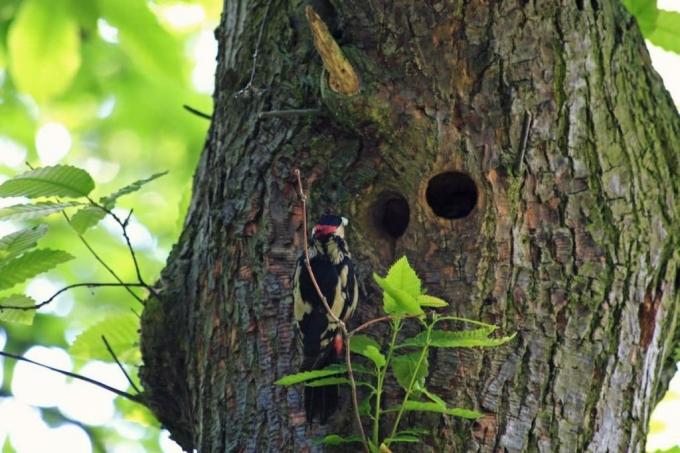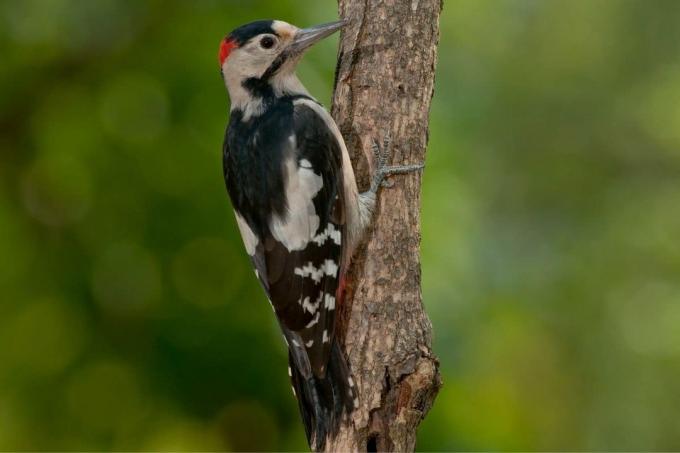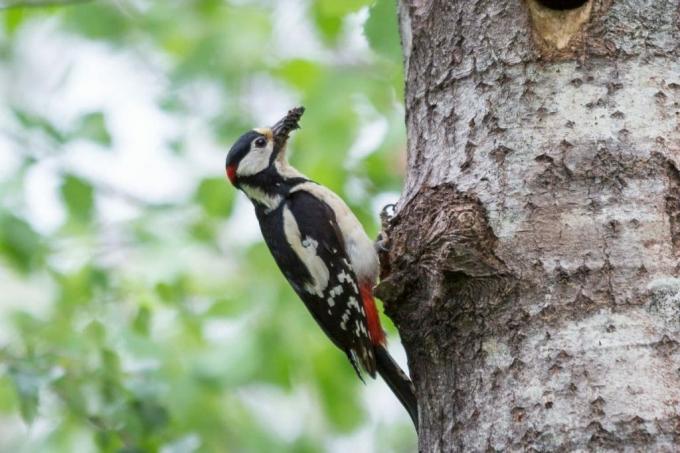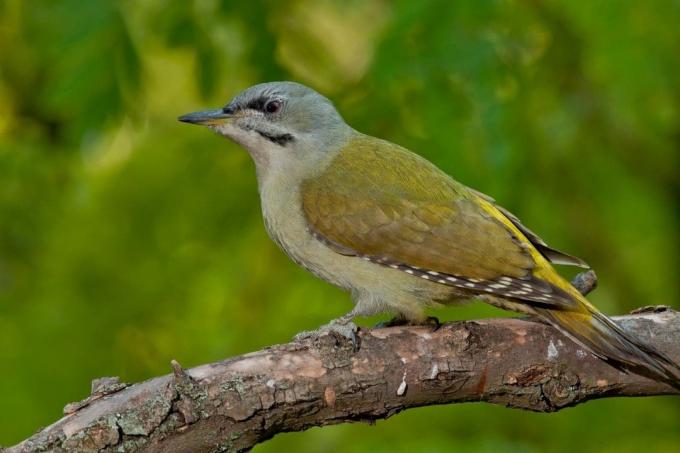
table of contents
- Woodpeckers (Picidae)
- Blood woodpecker (Dendrocopos syriacus)
- Great Spotted Woodpecker (Dendrocopos major)
- Three-toed woodpecker (Picoides tridactylus)
- Gray woodpecker (Picus canus)
- Green Woodpecker (Picus viridis)
- Little Woodpecker (Dendrocopos minor)
- Middle Woodpecker (Leiopicus medius)
- Black Woodpecker (Dryocopus martius)
- White-backed woodpecker (Dendrocopos leucotos)
- Reversible neck (Jynx torquilla)
- frequently asked Questions
Everyone knows the typical knocking sound when a woodpecker searches for food on trees. You probably know the great spotted woodpecker. We have compiled the characteristics of the ten native woodpeckers for you.
In a nutshell
- Woodpeckers distributed worldwide
- live singly or in pairs in forests
- Drumming in spring as part of the courtship ritual
- Woodpecker holes provide nesting opportunities for other animals
- three subfamilies: real woodpeckers, dwarf woodpeckers and reversible necks
Woodpeckers (Picidae)
With 28 genera and more than 200 species, woodpeckers are the most species-rich bird family within the order of the woodpecker birds (Piciformes). They mostly live on trees.
Typical features are:
- angular, firm chisel beak
- long, extensively protruding tongue
- Climbing feet
- stiffened support tail
Their main food is insects, which they chisel out of the tree bark with their powerful beak, but also seeds and nuts.

Their undulating flight and jumping movement on the ground are striking. Most woodpeckers are cave breeders. They carve their own tree hole with their beak themselves. Abandoned woodpecker caves are often used by other forest animals after they have moved out. The widely audible drum roll at the beginning of spring serves as a substitute for courtship singing and to demarcate the area.
Woodpeckers are divided into subfamilies
- Real woodpeckers (Picinae)
- Dwarf woodpeckers (Picumninae)
- Reversible necks (Jynginae)
The "real woodpeckers" known to us can be found almost everywhere in the world. They live mainly in near-natural forests. Dwarf woodpeckers are only found in the tropical regions of Africa, Asia and America. The smallest is the reversible neck subfamily with two species.
We present the main characteristics of the domestic woodpeckers.
Blood woodpecker (Dendrocopos syriacus)
The blood woodpecker is confusingly similar to the great spotted woodpecker. In contrast to this, his rump is pink and the connection between the black beard and the nape of the neck is missing. Blood woodpeckers are less marked and have more white in their plumage.
- Habitat: light deciduous forests, parks, gardens
- Size: 23 centimeters
- Weight: 83 grams
- Breeding season: May to July
- Breeding place: Tree hollows
- Incubation period: 11 days
- Clutch size: 3 to 6 eggs
- Food: Insects, worms, larvae, beetles, fruits, nuts, berries
- Enemies: Owls, martens
- Migratory bird: Standing bird
- Life expectancy: 8 years

Note: In contrast to the nuthatch, woodpeckers cannot walk down the tree upside down.
Great Spotted Woodpecker (Dendrocopos major)
Of the great spotted woodpecker is the most famous native woodpecker. The large white shoulder patches, the red rump, the black crown and the red neck patch in the male are striking.
- Habitat: Deciduous and mixed forests, parks
- Size: 23 centimeters
- Weight: 80 grams
- Breeding season: April to June
- Breeding place: Tree hollows
- Incubation period: 14 days
- Clutch size: 4 to 6 eggs
- Food: Insects, worms, larvae, beetles, seeds, nuts, berries
- Enemies: Eagle owl, sparrowhawk, hawk, marten
- Migratory bird: Standing bird
- Life expectancy: ten years

Three-toed woodpecker (Picoides tridactylus)
As its name suggests, the three-toed woodpecker does not have four toes like other species of woodpecker, but only three toes. The birds appear very dark, their black plumage is only banded white on the back and belly. Male birds have a yellow crown. There is no red color in the three-toed woodpecker.
- Habitat: Coniferous forests with a lot of dead wood, mainly in mountain regions
- Size: 23 centimeters
- Weight: 72 grams
- Breeding season: May to July
- Breeding place: Breeding caves
- Incubation period: 12 days
- Clutch size: 3 to 5 eggs
- Food: Insects, worms, larvae, beetles
- Enemies: Owls
- Migratory bird: Stand bird in Germany
- Life expectancy: 8 years

Note: Three-toed woodpeckers can only be observed in Germany in the mountain regions of the Alps and the Bavarian forest. They are rare, but not very shy.
Gray woodpecker (Picus canus)
A beautiful bird that is rarely seen in Germany is the gray woodpecker. It is colored similarly to the green woodpecker, but without a red crown. Gray woodpeckers have a gray head, a light underbelly and a light face. Males of this species of woodpecker have a small red spot on the forehead.
- Habitat: light deciduous and mixed forests, alluvial forests, parks, orchards
- Size: 30 centimeters
- Weight: 190 grams
- Breeding season: May to July
- Breeding place: Breeding caves
- Incubation period: 16 days
- Clutch size: 5 to 7 eggs
- Food: Insects, worms, larvae, ants, beetles, seeds, berries
- Enemies: Hawks, hawks, sparrowhawks, eagle owls, owls, raccoons
- Migratory bird: Stand bird in Germany
- Life expectancy: 12 years

Note: Gray woodpeckers are endangered in Germany.
Green Woodpecker (Picus viridis)
As the name suggests, the green woodpecker's back and tail are colored green. The rump is yellow-green. The red head and the dark face are striking. The male's beard is red and the female's black.
- Habitat: Deciduous and mixed forests with old trees, parks, orchards
- Size: 33 centimeters
- Weight: 220 grams
- Breeding season: May to July
- Breeding place: Breeding caves
- Incubation period: 15 days
- Clutch size: 5 to 7 eggs
- Food: Insects, worms, larvae, ants, beetles, seeds, berries
- Enemies: Hawks, hawks, sparrowhawks, eagle owls, owls, raccoons
- Migratory bird: Stand bird in Germany
- Life expectancy: ten years

Note: Green woodpeckers can often be seen on the ground looking for their favorite food: ants and their larvae.
Little Woodpecker (Dendrocopos minor)
The small woodpecker is next to the great spotted, medium and blood woodpecker the smallest representative of the black and white feathered species. In contrast to the male, the female does not have a red skull. The black back is banded in white on both. The bottom is dashed. The rump is not red in the small woodpecker.
- Habitat: Deciduous and mixed forests with a lot of dead wood, orchards
- Size: 15 centimeters
- Weight: 22 grams
- Breeding season: May to July
- Breeding place: Breeding caves
- Incubation period: 12 days
- Clutch size: 3 to 6 eggs
- Food: Insects, worms, larvae, beetles, ants, snails
- Enemies: Hawks, owls, sparrowhawks, eagle owls, martens
- Migratory bird: Stand bird in Germany
- Life expectancy: 8 years

Middle Woodpecker (Leiopicus medius)
The middle woodpecker prefers light oak and beech forests as a habitat. Its round head with the bright red top can be seen from afar. Its flanks are dashed and the under tail-coverts are light red in color. There is hardly any difference between males and females.
- Habitat: Deciduous and mixed forests with a lot of dead wood
- Size: 22 centimeters
- Weight: 75 grams
- Breeding season: May to June
- Breeding place: Tree hollows
- Incubation period: 14 days
- Clutch size: 4 to 7 eggs
- Food: Insects, worms, larvae, beetles, seeds
- Enemies: Hawks, owls, sparrowhawks, martens
- Migratory bird: Standing bird
- Life expectancy: ten years

Black Woodpecker (Dryocopus martius)
The black woodpecker is easy to recognize, completely black with a red parting and a very strong white beak. It is about the size of a crow, making it the largest native species of woodpecker. While the entire vertex glows red in the male, only the back of the head is colored red in the female.
- Habitat: remote deciduous and mixed forests with large old trees
- Size: 47 centimeters
- Weight: 360 grams
- Breeding season: April to June
- Breeding place: Breeding caves
- Incubation period: 14 days
- Clutch size: 3 to 5 eggs
- Food: Insects, worms, larvae, beetles, seeds, berries, nuts
- Enemies: Hawks, hawks, sparrowhawks, eagle owls, owls, raccoons
- Migratory bird: Stand bird in Germany
- Life expectancy: ten years

Note: The drumming of the black woodpecker is so loud and powerful that you can hear it for miles.
White-backed woodpecker (Dendrocopos leucotos)
The white-backed woodpecker is the largest of the black and white woodpecker species. It has a white back, a striking dashed chest and a cap that is as red as the middle woodpecker. You rarely get to see the beautiful bird. He is shy and avoids inhabited areas. The white-backed woodpecker is on the Red List of Endangered Species.
- habitat: remote forests with a high proportion of deadwood
- Size: 28 centimeters
- Weight: 110 grams
- Breeding season: May to July
- Breeding place: Breeding caves
- Incubation period: 15 days
- Clutch size: 3 to 5 eggs
- Food: Insects, worms, larvae, beetles, seeds, berries, nuts
- Enemies: Tawny owl, hawk, sparrowhawk, eagle owl, owls
- Migratory bird: Stand bird in Germany
- Life expectancy: 8 years

Note: Due to the similarity, the white-backed woodpecker is also known as the magpie woodpecker.
Reversible neck (Jynx torquilla)
The wryneck differs in appearance and behavior from the other species of woodpecker. Its plumage is gray-brown in color. In flight you can see a dark brown band on the back. The underside is light brown.
- Habitat: Vineyards, parks, gardens, orchards
- Size: 17 centimeters
- Weight: 44 grams
- Breeding season: April to July
- Breeding place: Breeding caves
- Incubation period: 15 days
- Clutch size: 5 to 10 eggs
- Food: Ants, larvae, insects, spiders
- Enemies: Hawks, hawks, sparrowhawks, eagle owls, owls, raccoons
- Migratory bird: winters in Africa
- Life expectancy: ten years

Note: Woodpeckers are important carpenters of the forest. After the breeding season ends, their burrows are used by titmice, squirrels, dormice and bats.
frequently asked Questions
With their hard, pointed beaks, woodpeckers can build their nesting holes not only in trees, but also in house facades. To avoid permanent damage from moisture, you should plug the hole. However, this is only allowed outside of the breeding season. For safety, contact the responsible nature conservation authority.
With the exception of the wryneck, all native woodpecker species are resident birds. In winter they look forward to an additional fatty food offer at the bird house. Put up a bowl of water as well, because birds also need liquid.
Create habitats for small animals and useful insects in the garden. Piles of leaves and brushwood provide shelter for many animals. Some windfalls can be left as animal food. In the garden, leave a few berries on the bushes and do not cut all the seed heads from the perennials. In this way, woodpeckers and other winter birds can still find seeds, insects, worms or snails even in the cold season.
Some species of woodpecker feed on insects that are found exclusively in dead wood. Three-toed woodpeckers, for example, hammer holes in spruce trees in search of food and slowly bring them to death. The bark beetle is at the top of their menu. The behavior, which is called "ringing", does not mean any danger to our forests, it is more a measure of landscape maintenance.



